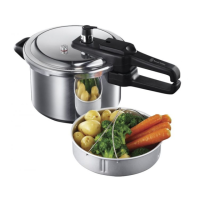start cooking
14 Lower the weight on to the vent pip, and check that it rotates freely.
15 Put the pressure cooker on the hob and set the hob to maximum heat.
16 If you’re using gas, don’t let the flames lick up the sides of the pressure cooker. You’ll damage
the handles, and you’ll lose control of the cooking process.
17 If you’re using any other heat source, use a ring or hotplate with the same diameter as (or
slightly smaller than) the base of the pressure cooker.
18 As the temperature and pressure inside the cooker increase:
a) the pressure indicator will rise till it’s just below the top of the lid lock
b) the weight will rise up the vent pipe and start to rotate
c) steam will issue from the vents in the weight
caution don’t touch the pressure indicator – you’ll release pressurised steam, which may
cause scalding
19 Now reduce the heat, to maintain a steady, gentle flow of steam from the pressure selector.
20 Start timing the cooking process now.
21 At the correct pressure, the weight will turn slowly and steam will come out of the vents.
22 If the pressure rises, the weight turns faster, more steam comes out, and the hissing gets
louder. This doesn’t cook faster, it just makes more steam, more noise, and wastes energy.
23 If the pressure falls, the weight stops turning, and the pressure indicator drops.
24 The trick is to regulate the heat so that it produces just enough pressure to keep the weight
turning and hissing.
25 Initially, you’ll have to fiddle around with the cooker control to get it just right. Judging the
right settings will become easier with use.
, Steam will escape from the lid, front handle and pressure indicator during cooking – this is
normal, don’t worry about it.
26 At the end of the cooking time, turn off the heat and remove the pressure cooker from the
hob, using both handles.
releasing pressure
26 There are two methods of releasing pressure:
quick Put the pressure cooker in the sink, under the cold tap.
Run cold water over the metal surface of the lid.
Don’t run water over the handles
Don’t submerge the pressure cooker in water
Steam will come from round the handle and indicator – keep clear
slow Leave the pressure cooker to cool naturally
Steam and pressure will be released slowly
27 The recipe should tell you which method to use. If it doesn’t, use the slow release method, to
avoid the escape of cooking liquids.
28 As the pressure is released, the indicator will retract into the handle. You won’t be able to
open the lid lock till the indicator has retracted fully.
opening the lid
29 To find out if the pressure indicator is fully retracted, push the lid lock in towards the weight.
30 If it won’t move, there’s still too much pressure inside the cooker.
31 Leave it to cool for a few minutes longer, don’t try to force it.
32 When the lid lock moves freely, use a cloth or oven gloves to remove the weight.
caution a lot of steam will come from the pressure selector – keep clear
33 If you’ve been cooking any doughy food, shake the pressure cooker gently before opening,
to avoid food being ejected when you open it

